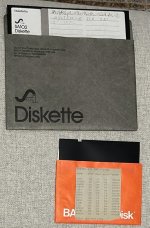per
Veteran Member
As posted in the DEC forum, I am archiving a pack of 8" floppy disks I came over. While most of those disks are for the PDP-11, one of the disks seems to be a release of FDOS-III for the Poly88. Does anyone here have experience with this?
I don't know enough about this system to say if this disk is bootable or not, but it does contain most of the system tools they put in their adverts (BASIC, Assembler, Editor). Format on the disk is Intel ISIS, and the programs are stored as Intel HEX format ASCII files with no file extension. Here is a file-listing:
I don't know enough about this system to say if this disk is bootable or not, but it does contain most of the system tools they put in their adverts (BASIC, Assembler, Editor). Format on the disk is Intel ISIS, and the programs are stored as Intel HEX format ASCII files with no file extension. Here is a file-listing:
- ISIS.DIR/ISIS.MAP/ISIS.T0/ISIS.LAB
- EXEC
- SYSGN
- HABMO
- FORMT
- COPY
- MTDK
- RDBLF
- EDIT
- ASMB
- LINK
- LIB
- DEBB

